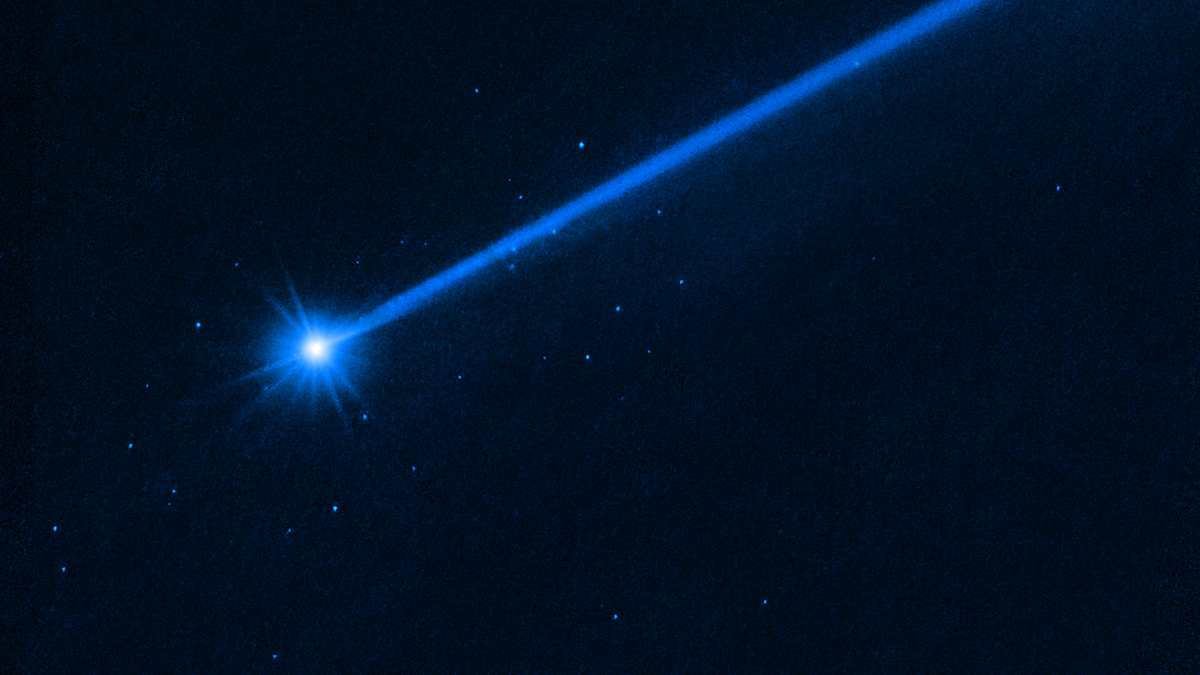
After the successful impact of NASA’s DART mission on the Dimorphos asteroid, scientists have encountered a series of unexpected outcomes, the latest being the unanticipated lengthening of the asteroid’s orbital period around its larger partner, Didymos.
In September of last year, NASA’s $308 million DART (Double Asteroid Redirection Test) mission deliberately collided with the Dimorphos asteroid. This fridge-sized spacecraft impacted the 525-foot-wide (160-meter-wide) asteroid at speeds of up to 14,000 miles per hour (22,500 kilometers per hour), aiming to change its orbital path around its larger partner, Didymos. The binary pair is situated 7 million miles (11 million kilometers) from Earth and doesn’t pose a threat to Earth—either before or after the redirection test.
Advertisement
The mission was a resounding success; the impact altered Dimorphos’s orbital period around Didymos by over half an hour, shifting its position by tens of meters. This achievement was far beyond the DART team’s goal of 72 seconds, marking the beginning of several unexpected outcomes. The experiment hints at the potential of using kinetic impactors to redirect dangerous asteroids, but the numerous questions arising from the DART mission suggest there’s much more for us to understand first.
During the impact with Dimorphos, a powerful recoil effect was observed. Dimorphos, believed to be a rubble pile asteroid made up of loosely connected rocks, pebbles, and dust, released a vast amount of material, known as ejecta, into space upon impact. Speaking to Gizmodo earlier this year, DART investigation team lead Andy Cheng described this effect as similar to a small rocket engine, explaining that it’s “kind of like a little rocket engine—you have a recoil, a reaction force from throwing off all the material.” This reaction significantly enhanced the force of the impact. In fact, the push was almost four times more potent than if the spacecraft had collided with an asteroid without any ejecta production, making the deflection much more efficient than anticipated, Cheng explained.
Advertisement
Advertisement
The second unexpected outcome from the DART experiment was the creation of a “boulder cloud” around Dimorphos. The impact tossed approximately two million pounds of dusty rock into space—enough to fill six or seven railroad cars. Using the Hubble Space Telescope, astronomers identified nearly 40 boulders in close proximity to Dimorphos. While these boulders don’t pose a threat to Earth, their presence suggests that deflecting a truly hazardous asteroid could result in potentially dangerous boulders heading toward our planet.
The third unexpected finding was recently presented at an American Astronomical Society meeting, conducted by researchers from the Thacher School and the University of California at Berkeley. Using the 0.7-meter Thatcher Observatory in Ventura County, California, the team measured Dimorphos’s orbital period 20 to 30 days post-impact. They discovered its orbital period had extended by approximately one minute, resulting in a 34-minute rotation around Didymos, up from the initial 33 minutes.
This was surprising, as the impact was expected to shorten the orbital period, implying that Dimorphos has been slowing down since impact day. The scientists are perplexed by this observation. In their arXiv preprint, they write:
We find that no mechanism previously presented for this system can account for this large of a period change, and drag from impact ejecta is an unlikely explanation. Further observations of the (65803) Didymos system are needed to both confirm our result and to further understand this system post impact.
Advertisement
One theory suggests that the rapidly forming and evolving massive debris cloud, which is developing into clumps, spirals, and other structures, might be impacting Dimorphos’s trajectory. However, the authors of the recent study are not convinced that this phenomenon is the root cause of the prolonged orbital period.
Before the DART mission, Dimorphos’s orbital period was already undergoing slow changes. Still, the observed differences can’t be explained by several known mechanisms, according to the researchers. These include the binary YORP effect (a force from sunlight that changes the spin of two orbiting bodies), mutual tides (gravitational influences between objects), differential Yarkovsky force (a push due to sunlight absorption and heat emission), or the result of the sudden loss of surface mass.
Related article: NASA’s DART Is No More, but This Future Probe Is Hoping to Take a Second Look
Further observations and insights from more scientists are clearly needed on the matter. An important contribution to this research will come from the forthcoming Hera mission. The European Space Agency (ESA) is set to launch the Hera probe in October 2024, and it’s meant to closely study the Didymos-Dimorphos binary system and delve deeper into the results of the DART experiment. Including those weird and unexpected ones.
Advertisement
For more spaceflight in your life, follow us on X (formerly Twitter) and bookmark Gizmodo’s dedicated Spaceflight page.
Services Marketplace – Listings, Bookings & Reviews